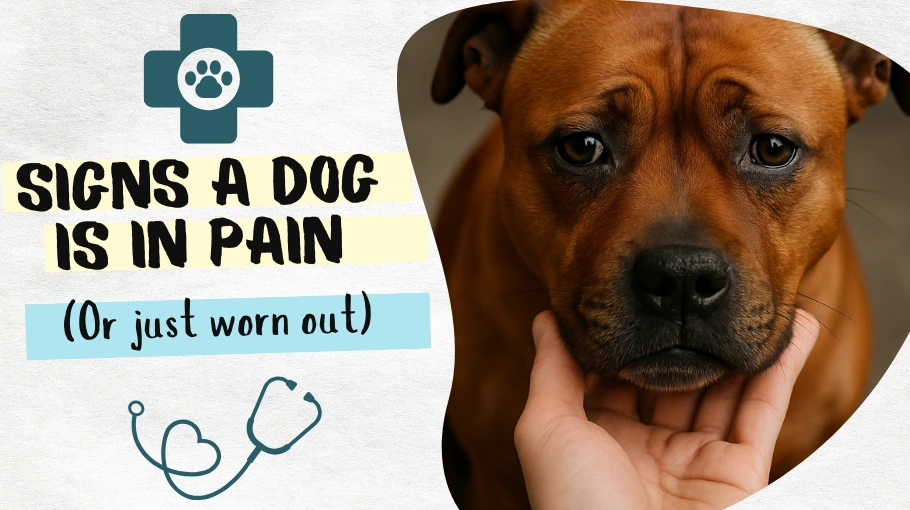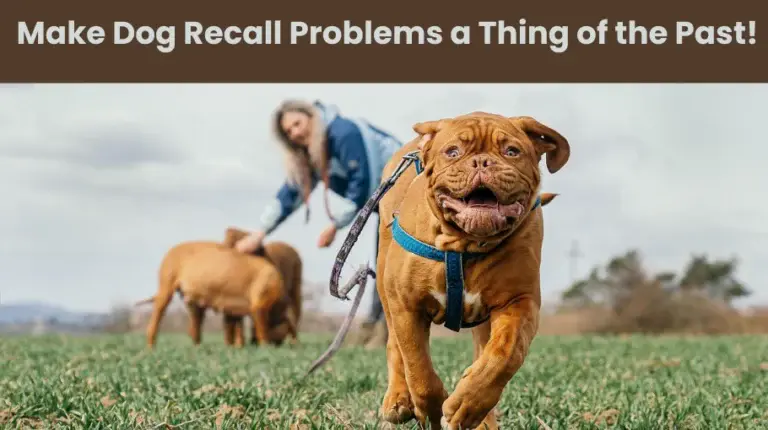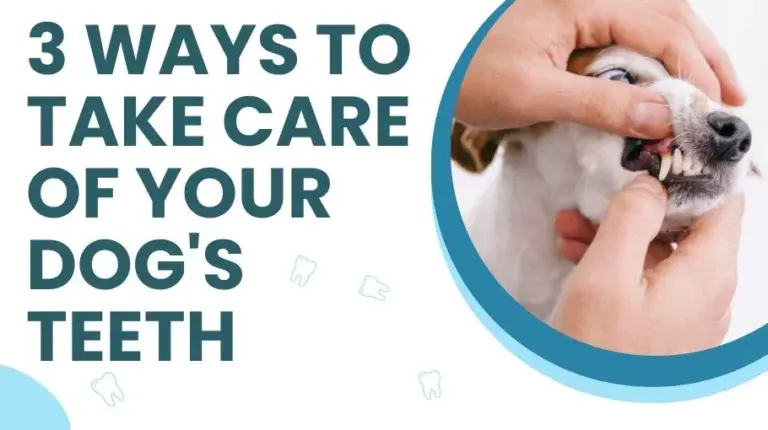Signs A Dog Is In Pain (Or Just Worn Out?)

Spotting the signs a dog is in pain isn’t straightforward, because they’re wired to hide pain. It’s instinct. In the wild, showing weakness could make them a target.
Staffies can be especially hard to read. They’re known for being stoic, so they often won’t show pain until it’s really bothering them.
And then there are the everyday things that throw us off. Not everything that looks serious actually is—but those same signs could mean something more.
Like the time I took our dogs on a steep uphill walk a bit too late in the morning. They started panting hard, limping like they’d run a marathon. I had to stop, let them nap for 20 minutes in the shade, and head straight back down. They weren’t injured—just worn out from the heat and the climb.
Another time, we gave our older Staffy something that didn’t agree with him. He stopped going to the toilet, and we ended up needing a vet visit—while on holiday. Thankfully, a few injections sorted him out, and he was back to darting around the beach the next day.
Stuff like this shows why it’s important to know the signs and think back on what’s happened recently. Is it pain? Is it just too much exercise? Did they eat something odd?
And with vets being so busy these days, being a bit more switched-on at home helps everyone—especially your dog.
Table of Contents
Spotting Physical Signs a Dog is in Pain
Dogs can’t say they’re hurting, but their bodies often do.
Here are some physical signs the American Kennel Club advise to keep an eye on:
- Tight or twitching muscles – It can look like a flinch or shiver.
- Shaking or trembling – Not just from being cold. Discomfort can cause this too.
- Arched back or stiff posture – If they’re holding themselves rigid, something might be off.
- Head held low – If they’re dropping their head below their shoulders for no clear reason, it’s worth noting.
- Panting when resting – After a run, sure. But if they’re panting while doing nothing, that’s a flag.
These things don’t always mean pain—but they can. And they’re especially worth tracking after:
- A change in food – probiotics can ease stomach upsets when switching food brands. See the dog food guide for Staffies.
- A new supplement or medication
- A long walk
- Playtime on rough or hot surfaces
You don’t have to panic at the first sign—but noticing small changes early can help you avoid bigger issues later.
Behaviour Changes That Could Mean Pain
Pain often shows up in behaviour before anything physical. If your dog’s suddenly acting different, it’s worth paying attention.
Here are some signs:
- Avoiding touch – If they pull away from cuddles or flinch at pats, something could hurt.
- Licking one spot over and over – This can mean they’re trying to soothe an area that’s sore.
- Whimpering, yelping, or howling – Even quiet dogs might make noise when they’re in pain.
- Restlessness – If they’re pacing or can’t settle, it might be because they’re uncomfortable. It’s also a reason dogs dig their beds. Not always because they’re nervous.
- Aggression or snapping – A normally friendly dog might lash out if a sore spot gets touched.
- Sleeping more—or struggling to sleep at all – Either can be a reaction to pain.
- Becoming withdrawn – When our usually social Staffy started keeping to himself, it was the first clue something was wrong. Our go-to now is to check for ticks because those can cause dogs to withdraw. For more on that, read: How to Prevent Dog Ticks.
These changes might come on gradually or feel like a sudden switch. Either way, they’re your dog’s way of saying, “Something’s not right.”
Mobility Issues to Watch For
When a dog has pain, it often shows in how they move. If your dog’s struggling to get around, it could be a sign something’s wrong.
Here’s what to look for:
- Limping – If they’re limping or dragging a leg, it’s usually a sign of pain.
- Slowing down – A dog that usually loves walks but suddenly stops or lags behind might be hurting, or it may just too long a walk.
- Reluctance to jump or use stairs – If they’re avoiding stairs, couches, or other jumps, pay attention.
- Difficulty lying down or getting up – Moving stiffly or with hesitation can mean joint pain or discomfort.
Sometimes, mobility issues come from things like rough play or hot pavement. But if it lasts or seems to get worse, it could point to a deeper problem.
Pay attention to what they’ve been up to, and take note if their movement starts to change.
Reviewing Recent Activities and What They Might Mean
Sometimes, the best way to figure out if your dog’s in pain is to think back over the past few days. What’s been different?
Here’s what to consider:
- Exercise overload – Maybe that extra-long walk was too much for them. Even our energetic dogs have limits. See: Exercise Induced Collapse in Dogs to spot the signs of that.
- Something they ate – If they’ve nibbled on something new (or something they shouldn’t have), it could upset their stomach or cause pain later.
- Jumping down from heights – Landing awkwardly can lead to strains or sprains.
- Weather – Extreme heat or cold can wear them down. Lack of water or being outside too long can make them feel off.
- Medications or vaccinations – If they’ve had a recent shot or started a new medication, it might cause temporary discomfort.
Tracking these things helps create a clear picture. When you’re ready to talk to the vet, having all this info can save time and make the process smoother.
When to Call the Vet
Knowing when to call the vet isn’t always obvious. But there are a few signs that mean it’s time to reach out.
Look for these:
- Pain that doesn’t ease – If your dog’s discomfort sticks around for hours or gets worse, it’s time to call the vet.
- Refusing food or water – If they won’t eat or drink for more than a few hours, something’s wrong.
- Yelping when touched – If they react sharply to being touched in certain areas, they’re in pain.
- Swelling, bleeding, or seizures – These are signs that require immediate attention.
- Gut feeling – Trust your instincts. If something doesn’t seem right, don’t wait too long to get help.
Many vets now offer phone or video consultations, which can be a lifesaver if appointments are hard to get. The more details you can give them, the quicker they can help.
Trusted Resources:
Conclusion and Empowerment
Being mindful of your dog’s well-being is a loving responsibility. Recognising pain doesn’t always signal an emergency, but it definitely shouldn’t be brushed aside either.
With all the signs discussed here, use them as tools of insight rather than sources of anxiety. Tracking the changes and jotting down notes serves as a roadmap for you and your vet to navigate.
When doubts arise, err on the side of caution and reach out to a professional. Arm yourself with observations—nothing is too small to note when it comes to your furry sidekick’s health.
Staying proactive helps not just your own dog but supports a culture of care and attentiveness within the dog-loving community. Looking out for each other means everyone benefits, including our spirited Staffies.






